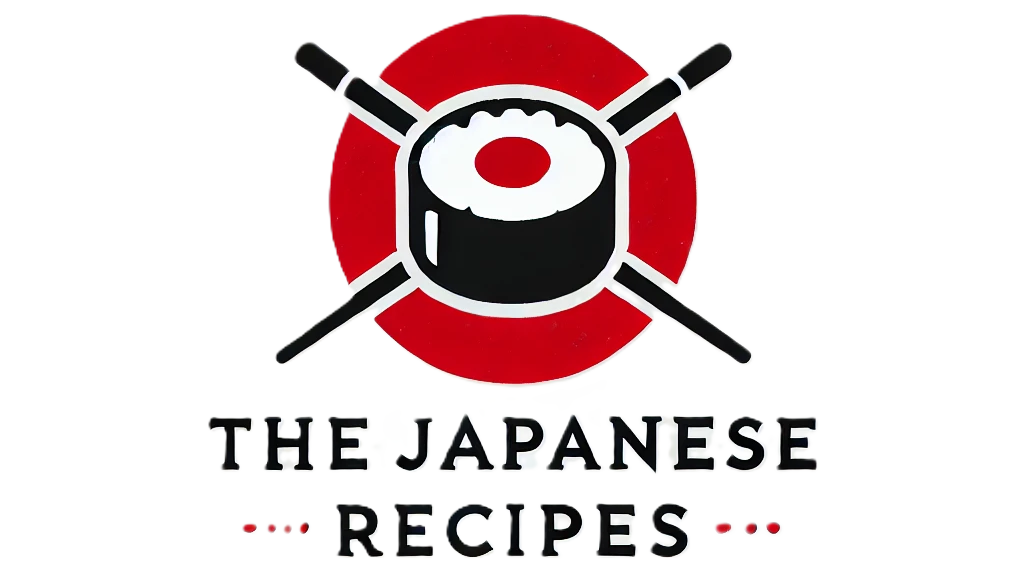Are you intrigued by the sweetness and versatility of corn? Look no further than the japanese corn recipe approach to discover bold flavors, unique cooking techniques, and a touch of tradition. Within the first bite, you’ll notice how corn takes center stage as a satisfying ingredient in soups, rice dishes, and grilled delights. Whether you’re seeking corn with rice recipes or hoping to explore miso corn as a savory treat, the diversity of Japanese cuisine has something to offer.
For an even broader look at how you can incorporate corn and other vegetables into your everyday cooking, check out our guide on Vegetables Japanese Recipe for tips on preparation, seasoning, and plating. Ready to embark on your next culinary adventure? Let’s get started!
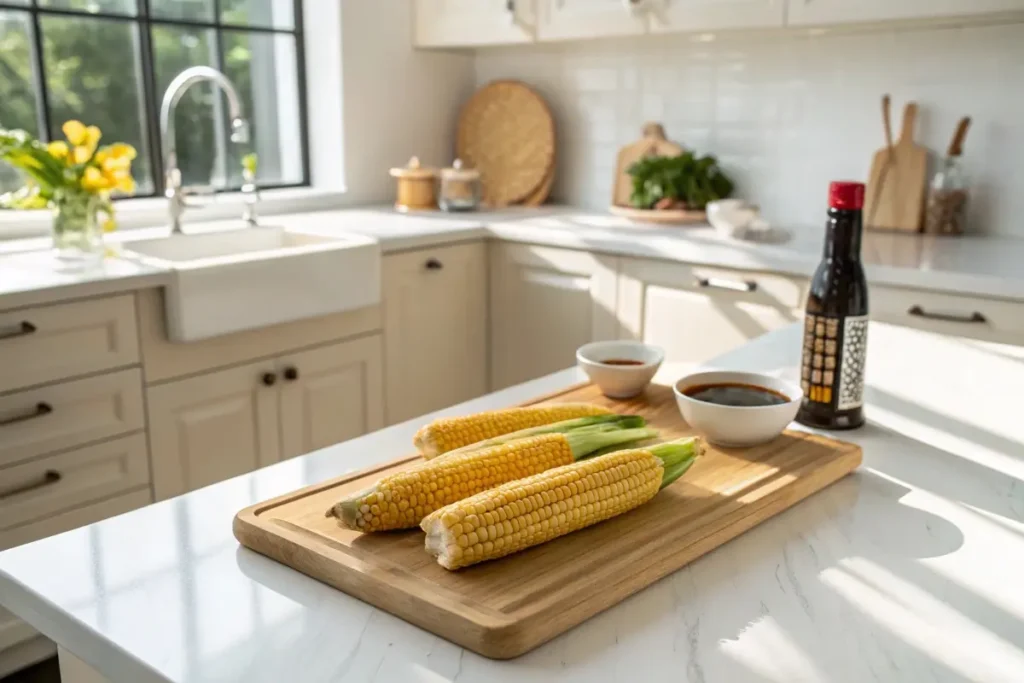
The Popularity of Corn in Japan
Corn is ubiquitous in Japanese cuisine, appearing in everything from street snacks to hearty comfort foods. You may wonder, Why do Japanese people like corn so much? The simple answer is its versatility. Japan’s four distinct seasons inspire dishes that feature fresh, local produce, and corn stands out as a summer staple with a sweet yet subtly earthy flavor.
Corn on the Cob – A Summertime Treat
During the warmer months, you’ll see corn on the cob sold at festivals and markets. This might come grilled over open coals, basted with soy sauce, or boiled with a sprinkle of salt. If you’re looking to recreate a classic street-food experience, try brushing butter mixed with soy sauce onto the cob before grilling. The toasty char and savory accents transform a simple cob into a robust snack.
From Soup to Salad
Corn also appears in soups, such as a light miso corn soup or a creamy corn potage, popular in Japanese cafés. Additionally, kernels often top salads or pizzas—Japanese fusion pizzerias love adding sweet corn to balance tangy tomato sauce and melted cheese. Because of this adaptability, you’ll find corn at both traditional and modern dining tables.
Incorporating Corn with Rice
When it comes to corn with rice recipes, Japan excels at creating rice and corn dishes that are both comforting and nutritious. Steamed rice mixed with fresh corn kernels yields a mildly sweet taste that complements rich main dishes like grilled fish or chicken. Some cooks even add a dab of butter and a splash of soy sauce to corn rice for a richer flavor profile.
A Reflection of Culinary Exchange
Corn is not native to Japan; it was introduced by early traders and missionaries. Over centuries, Japanese cooks have made it their own, exemplifying how the culture adopts foreign foods while preserving local identity. The result? A range of asian corn recipe options that blend seamlessly with traditional Japanese elements, from miso to mirin.
If you’d like more inspiration for incorporating unexpected ingredients in Japanese dishes, explore our Japanese Barbecue Sauce Recipes to discover flavorful sauces that also pair well with corn-based meals. Whether grilled, boiled, or sautéed, corn in Japan remains a favorite for its gentle sweetness and adaptability in diverse culinary creations.
Key Ingredients and Seasonings for a Japanese Corn Recipe
To unlock the sweet and savory potential of corn in Japanese cooking, a well-chosen set of seasonings is essential. These add depth and complexity, turning a simple cob of corn into a symphony of flavors.
1. Miso Paste
Miso paste, made from fermented soybeans, is a cornerstone of Japanese cuisine. It lends a salty-sweet, umami-rich layer to dishes, making it a perfect companion for corn. A miso corn glaze often involves combining miso with mirin and sugar. This mixture brushed onto lightly grilled corn creates a caramelized exterior that’s both tangy and sweet.
2. Soy Sauce
Soy sauce is indispensable in Japanese cooking. It’s salty, earthy, and a little goes a long way. When applied to grilled corn, soy sauce helps achieve that signature smoky umami flavor, especially when combined with butter or oil. If you’re looking for a quick marinade, whisk together soy sauce, grated ginger, and a bit of sake, then brush it onto corn before grilling or broiling.
3. Dashi
Dashi, a simple broth made from kelp (kombu) and bonito flakes, is the backbone of many soups and simmered dishes. While dashi might not always appear in a typical grilled corn recipe, you’ll find it in soups and braised corn dishes. Dashi imparts a gentle marine essence that heightens the sweetness of corn without overpowering it.
4. Mirin and Sake
Mirin is a sweet rice wine, while sake is a fermented rice beverage commonly used in marinades. Both offer subtle sweetness and a polished finish, rounding out the flavors in marinades or sauces. For instance, a quick marinade of mirin, sake, and soy sauce can be drizzled over corn kernels in a skillet or added to rice and corn for a one-pot delight.
5. Butter and Mayonnaise
You may not instantly associate mayonnaise with Japanese cooking, but in Japan, mayonnaise is a beloved condiment. Corn often features in Japanese mayonnaise-based salads or as a topping for pizza. Butter, on the other hand, is a Western addition that’s now wholeheartedly adopted—think grilled corn rubbed with butter and soy sauce. If you enjoy rich and creamy textures, these two ingredients can add a modern twist to your japanese corn recipe.
For more insight on balancing flavors in Japanese cuisine, head over to our Japanese Vegan Recipes page. Even if you’re not strictly vegan, the techniques for enhancing natural sweetness and umami can apply to countless corn-based dishes. With the right seasonings in hand, you’ll be well-prepared to create an unforgettable dish that reflects the best of Japan’s culinary repertoire.
Cooking Methods and Techniques
Corn lends itself to various cooking methods in Japanese cuisine, from grilling over charcoal to simmering in soups. Each method showcases a different aspect of corn’s flavor and texture. If you’re curious about How do Japanese eat corn on the cob?, the following techniques will give you a glimpse into the many possibilities.
1. Grilling (Yaki Corn)
Grilled corn, known locally as yaki tomorokoshi, is a popular festival food. The cobs are typically basted with a soy sauce or miso glaze, then placed over open flames or charcoal. This process infuses a smoky aroma, enhancing the natural sweetness. The surface caramelizes, creating a slight crunch around each kernel. You’ll often see it served with a stick for easy munching.
2. Boiling and Steaming
For a simpler approach, corn on the cob is commonly boiled or steamed with just a pinch of salt. This preserves the pure taste of fresh corn. Once cooked, the kernels remain juicy, and you can top them with butter or mayonnaise. Some Japanese households also incorporate dashi or kombu into the boiling water, subtly enhancing the flavor without overshadowing the corn’s sweetness.
3. Sautéing or Stir-Frying
When working with kernels instead of whole cobs, sautéing is a favored technique. Combine fresh or frozen corn kernels with vegetables such as bell peppers or onions, then add soy sauce or miso for extra depth. This method can transform leftover corn into a quick side dish. If you like a bit of heat, toss in chili flakes or shichimi togarashi (a seven-spice blend).
4. Braising in Soups and Broths
Corn also appears in light soups and miso-based broths. Chunks of corn on the cob can simmer alongside potatoes, carrots, and green onions in a hearty stew. Alternatively, you can puree corn to create a creamy potage—a popular addition in Japanese cafés. The advantage of this method is that it allows the corn’s juices to blend harmoniously with the surrounding ingredients.
5. Incorporating Corn into Rice
Corn rice recipe (tomorokoshi gohan) is a hallmark of Japanese home cooking, especially in the summer. Here, kernels are added to the rice cooker along with water, salt, and sometimes a knob of butter. The result is a lightly sweet, aromatic bowl of rice and corn that pairs well with grilled fish or meat. If you’d like to elevate this dish, consider mixing a spoonful of miso or a dash of soy sauce into the cooking water.
Curious about more ways to blend modern cooking with traditional Japanese methods? Check out our Modern Japanese Breakfast article for tips on fusing old and new flavors. With these techniques in your arsenal, you can enjoy corn year-round, but especially when it’s at its seasonal peak.
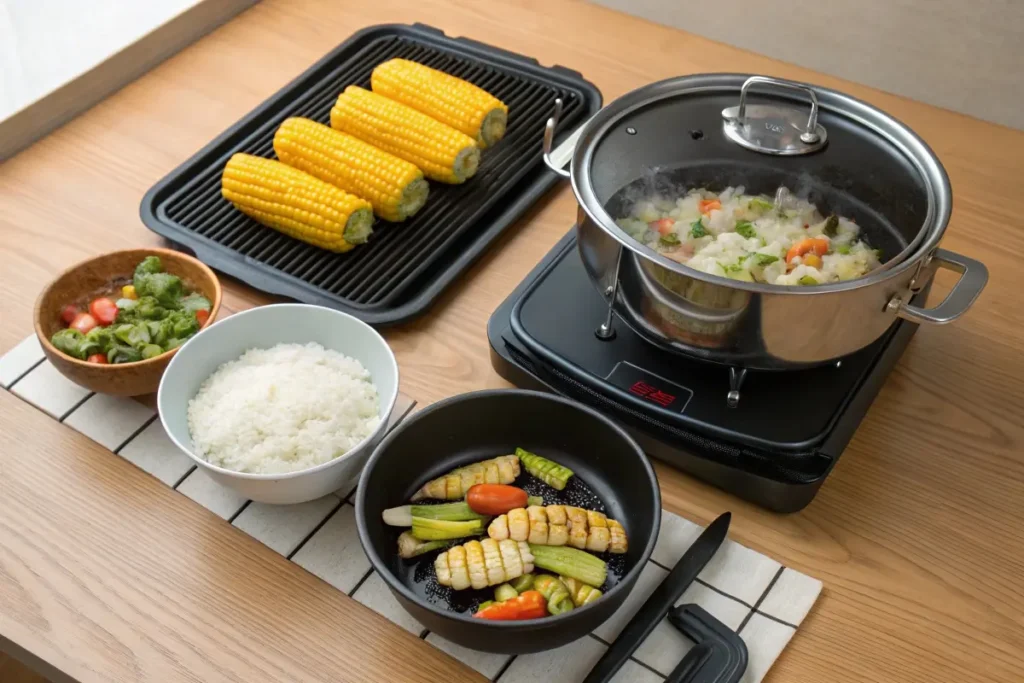
Exploring Robata Corn and Japanese Elotes
In modern fusion cuisine, corn has leapt from traditional staples to innovative street-food mashups. Perhaps you’ve heard of robata corn or the concept of “Japanese elotes” that parallels Mexican street corn. What is the difference between Japanese elotes and Elotes? Let’s dive into these creative adaptations that highlight global influences while celebrating Japanese techniques.
What Is Robata Corn?
Robata, short for robatayaki, refers to a style of cooking over charcoal at varying heights. It’s rooted in northern Japanese fishing villages, where fishermen grilled their daily catch on small fires within their boats. Today, robata has expanded to high-end restaurants and izakayas, featuring grilled seafood, vegetables, and yes, corn. Robata corn often involves husk-on grilling, allowing the kernels to steam in their natural wrapper before the husk is peeled back for that final charring. A miso or soy-based glaze is frequently brushed on to intensify the smoky sweetness.
Japanese Elotes vs. Traditional Elotes
In Mexican cuisine, elotes are grilled corn on the cob smeared with mayonnaise, chili powder, and cheese (usually cotija). The Japanese spin on elotes can include a miso mayonnaise mixture, bonito flakes instead of cheese, or the addition of soy sauce and wasabi. Essentially, the difference is in the flavor profile:
- Mexican Elotes:
Emphasize tangy cheese, bright chili, and fresh lime juice. - Japanese Elotes:
Lean on miso or soy sauce for umami, possibly adding savory bonito flakes or furikake (a Japanese seasoning blend).
Both versions share the characteristic of grilled corn with a creamy, tangy topping, making them a global street-food favorite.
Fusion Ideas for Corn
- Miso Mayo Spread:
Combine mayonnaise with white miso, a dash of chili powder, and a little sugar. Spread this onto grilled corn, then finish with chopped green onions. - Togarashi Sprinkle:
Replace chili powder with shichimi togarashi for a Japanese twist. This spice blend typically includes chili pepper, orange peel, sesame seeds, and nori flakes. - Bonito Flakes:
Top your Japanese elotes with light, papery bonito flakes that dance with the heat, adding a mild seafood undertone.
If you want to explore more cross-cultural tastes, be sure to see our Japanese Shrimp Recipes for additional inspiration. Much like corn, shrimp adapts well to marinade-driven and grilled preparations, so combining these two ingredients can yield an unforgettable surf-and-turf style meal. Whether you lean toward traditional or experimental, these creative spins offer a fun take on a global favorite.
Japanese Corn with Rice – The Perfect Comfort Meal
One of the most cherished ways to enjoy corn in Japan is in combination with rice. The mild sweetness of fresh kernels and the fragrance of cooked rice form a comforting duo, often referred to as corn rice recipe or tomorokoshi gohan. This meal exemplifies the harmony of flavors characteristic of Japanese cuisine.
The Basics of Corn Rice
To prepare tomorokoshi gohan, you’ll need:
- 2 cups of short-grain Japanese rice
- 1-2 ears of fresh corn (kernels removed)
- 2 cups of water or dashi
- 1 tablespoon of butter (optional)
- Salt or soy sauce to taste
- Rinse the Rice: Gently wash the rice until the water runs clear, removing excess starch.
- Add Ingredients: Place the rice, water or dashi, corn kernels, and optional butter into a rice cooker or pot.
- Season: Add salt or a splash of soy sauce for extra flavor.
- Cook: Follow your rice cooker’s instructions or simmer on a stovetop until tender.
- Fluff and Serve: Let the rice sit for 5 minutes, then gently mix to distribute the corn kernels evenly.
Variations to Explore
- Miso Corn Rice: Stir a tablespoon of miso paste into the cooking water for a deeper umami experience.
- Herb Twist: Add chopped green onions or shiso leaves just before serving to introduce fresh notes.
- Cheesy Corn Rice: While not traditionally Japanese, a handful of shredded cheese creates a fusion dish reminiscent of Western-style comfort food.
Pairing Suggestions
- Grilled Fish or Chicken: The sweetness of the corn rice balances the savory depth of grilled salmon or teriyaki chicken.
- Vegetable Sides: Steamed or roasted vegetables, such as zucchini or bell peppers, round out the meal while adding more color.
- Pickles and Soup: Japanese pickles (tsukemono) and miso soup provide tanginess and warmth, contrasting the gentle sweetness of the rice and corn.
For an even more filling option, add your favorite protein directly to the rice cooker, such as chunks of chicken or tofu, effectively creating a one-pot meal. If you’re seeking more creative ways to cook with rice, try our Japanese Chicken Fried Rice Recipe for a vibrant dish that can be adapted to include corn kernels, too.
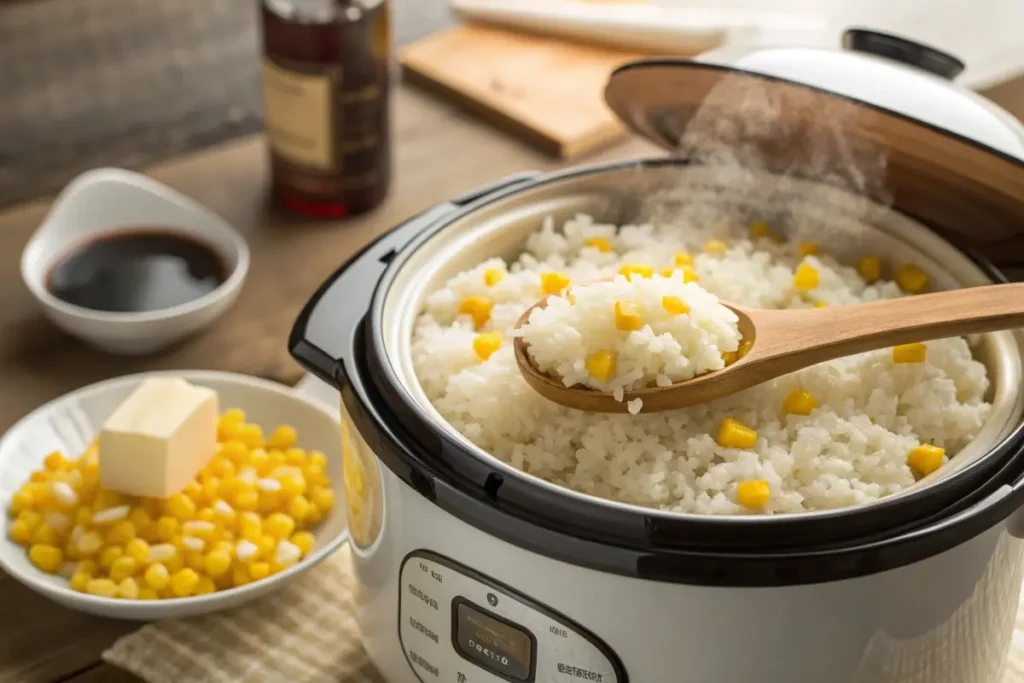
History and Context of Japanese Corn
Though corn is now woven into the fabric of Japanese cuisine, it didn’t originate in Japan. Understanding how it traveled across oceans and evolved in local culinary traditions adds depth to the story of the japanese corn recipe.
Early Arrival and Adoption
Corn first came to Japan via European traders and missionaries in the 16th century. Initially, it wasn’t a primary crop. Rice, wheat, and barley overshadowed corn due to established farming practices. Over time, however, farmers in northern regions like Hokkaido began cultivating corn, drawn by the area’s cooler climate that proved suitable for this new plant.
Influence of Global Exchanges
Japan has historically shown a readiness to embrace foreign ingredients. Corn was no exception, eventually making its way into local diets through experimentation in both home cooking and street foods. The popularity of Western-style restaurants also played a role, as dishes like corn potage soup became more accessible. This cross-cultural exchange enriched Japan’s culinary landscape, paving the way for fusion dishes that combine miso, soy sauce, and other local seasonings with corn.
Corn in Agricultural Policy
In the post-World War II era, Japan’s agricultural policies underwent shifts to ensure food security. Corn emerged as a valuable crop, not only for human consumption but also as animal feed. Innovations in farming techniques increased yield and quality, making fresh corn more widely available in supermarkets. Today, Hokkaido is celebrated for its sweet and juicy corn, which frequently appears in tourist shops and local markets, especially during the summer harvest.
Regional Specialties
Corn-based dishes vary across regions:
- Hokkaido Cream Corn Soup: This thick, comforting soup highlights the region’s dairy products and sweet corn.
- Okinawan Fusion: In subtropical Okinawa, corn might appear in stir-fries or local cafés, blending Japanese elements with the area’s distinctive ingredients like pork belly and bitter melon.
- Tokyo Street Food: Food stalls in the capital city often feature grilled corn (yaki tomorokoshi) at summertime festivals, reflecting the metropolitan blend of traditional and modern.
Over the centuries, corn went from an imported novelty to a beloved staple intertwined with Japanese traditions. Whether you enjoy grilled robata corn at an upscale restaurant or a simple bowl of rice and corn at home, you’re partaking in a cultural journey that spans continents and generations. If you’d like to see how other ingredients made similar transitions, check out our Traditional Japanese Desserts Recipe for a glimpse of how global influences shaped sweet treats too.

Practical Examples/Use Cases
Corn’s adaptability in Japanese cooking goes beyond the usual grilled or boiled versions. Here are some relatable, everyday ways to use japanese corn recipe ideas in your kitchen:
1. Busy Weeknight Dinner
- Dish: Miso-Glazed Corn and Rice
- Method: While your rice cooks, sauté corn kernels in a mix of miso, butter, and a dash of mirin. Stir the mixture into your freshly steamed rice.
- Why It Works: You get a fully flavored meal in under 30 minutes. Pair it with a simple side of pickled veggies.
2. Entertaining Guests
- Dish: Japanese Elotes on a Grill
- Method: Grill corn cobs and then slather them with a blend of mayonnaise, miso paste, and chili flakes. Top with bonito flakes or furikake.
- Why It Works: Guests love the fusion twist, and it’s easy to serve as an appetizer at barbecues or parties.
3. Kid-Friendly Lunchbox
- Dish: Corn Onigiri (Rice Balls)
- Method: Combine corn kernels with seasoned rice, shape into balls, and wrap in nori. Include a side of tamagoyaki (rolled omelet) for protein.
- Why It Works: The sweet flavor of corn appeals to children, and onigiri is portable for school or picnics.
4. Health-Conscious Meal Planning
- Dish: Corn and Tofu Soup
- Method: Simmer fresh corn kernels, tofu cubes, and green onions in a dashi-based broth. Season lightly with soy sauce.
- Why It Works: This soup is both light and rich in protein. Perfect for those watching their calorie intake or seeking vegetarian-friendly dishes.
5. Comfort Food in Cooler Months
- Dish: Creamy Corn Potage
- Method: Sauté onions and corn in a bit of butter, then add vegetable or chicken stock. Puree until smooth and stir in warm milk.
- Why It Works: It’s a warming, creamy soup with a gentle sweetness—ideal for cold evenings.
To further tailor these recipes to your taste, consider browsing our Discover Japanese Recipes for additional side dish ideas that pair seamlessly with corn. Whether you’re hosting a party or prepping a quick meal for the family, these use cases illustrate just how flexible and appealing Japanese-inspired corn dishes can be.
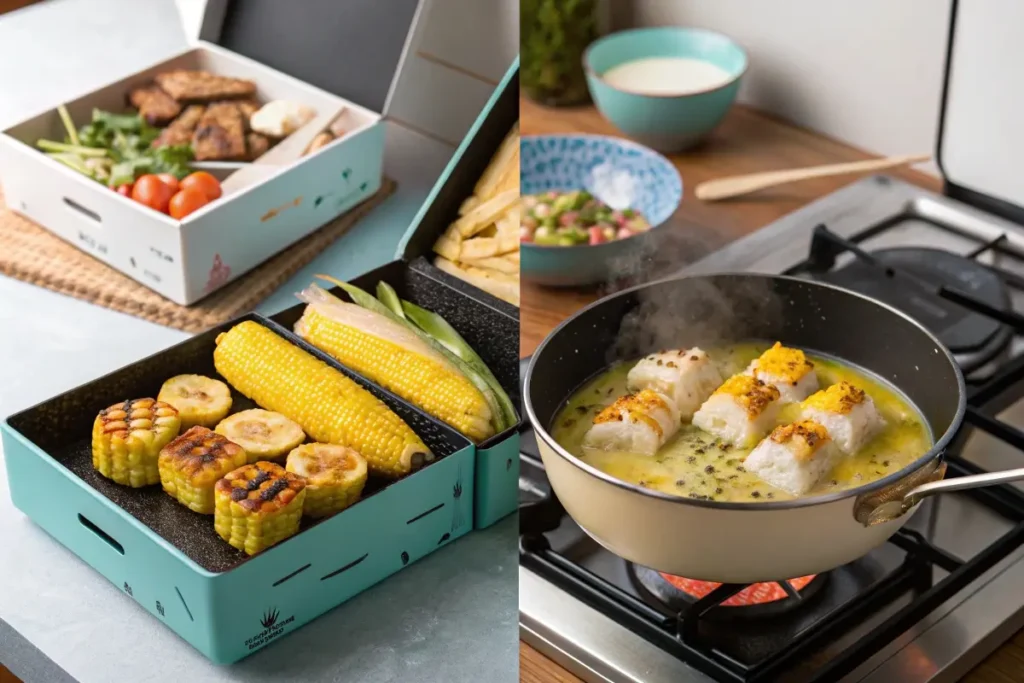
FAQs
Below are answers to some frequently asked questions about japanese corn recipe traditions and related topics.
- What is the difference between Japanese elotes and Elotes?
Elotes are a classic Mexican street food involving corn on the cob coated in mayonnaise, chili powder, and cheese. Japanese elotes use similar grilling techniques but integrate ingredients like miso paste, soy sauce, or bonito flakes instead of cheese. The flavor profile is more umami-focused, while Mexican elotes lean on tanginess and spice. - Why do Japanese people like corn so much?
Japan’s appreciation for corn stems from its versatility and natural sweetness. Over time, corn became a local favorite due to successful cultivation in regions like Hokkaido. It appears in everything from street snacks to soups and even fusion pizzas, reflecting the Japanese culinary approach of adapting foreign ingredients with local twists. - How do Japanese eat corn on the cob?
Corn on the cob is often grilled (yaki tomorokoshi) and brushed with soy sauce or miso-based glazes. It can also be boiled or steamed, then topped with butter or mayonnaise. During summer festivals, you’ll commonly see vendors selling grilled corn skewered on sticks for easy snacking.
What is robata corn?
- Robata refers to a style of charcoal grilling. Robata corn involves slowly roasting cobs over charcoal, sometimes with husks on, then finishing them with miso or soy sauce. This technique imparts a smoky aroma and intensifies the corn’s inherent sweetness.
- Are there variations of corn integrated into rice dishes?
Yes. Tomorokoshi gohan (corn rice) is a quintessential asian corn recipe in Japan. The kernels are cooked with rice and can include seasonings like butter, salt, and sometimes miso or soy sauce. The result is a lightly sweet, aromatic dish perfect for pairing with grilled fish or chicken. - Can I use frozen corn instead of fresh corn?
Absolutely. While fresh corn offers optimal sweetness, frozen corn works well, especially in soups, stir-fries, or mixed with rice. Just adjust cooking time accordingly, as frozen kernels usually need less time to heat through. - Do Japanese restaurants outside Japan serve these corn dishes?
Many Japanese restaurants abroad feature corn-based offerings like miso corn ramen or grilled corn appetizers. You can also try making these dishes at home for a more authentic experience.
Conclusion
With its sweet flavor, vibrant color, and remarkable versatility, corn has found a comfortable home in Japanese cuisine. Whether you’re preparing miso corn, experimenting with robata corn, or cooking a comforting pot of rice and corn, each dish highlights the harmony of sweet and savory that defines Japan’s culinary identity. You can grill it, boil it, or stir it into soups and salads—the possibilities truly seem endless.
Incorporating these japanese corn recipe ideas into your routine is a simple yet effective way to diversify your meals. By using familiar seasonings like soy sauce and miso, you’ll discover that corn can seamlessly blend into various dishes, adding a bit of sweetness to balanced umami flavors. For further exploration of how you can fuse tradition with innovation, Japanese Corn Recipe offers even more in-depth guides and tips to help you master each technique.
Now is the perfect time to invite friends or family to savor these delightful corn-inspired meals. Break out the grill or fire up your stovetop, and let the distinctive aroma of Japanese-style corn enrich your cooking repertoire. Embrace the sweet kernels, experiment with tangy toppings, and enjoy how a single ingredient can awaken so many taste buds.
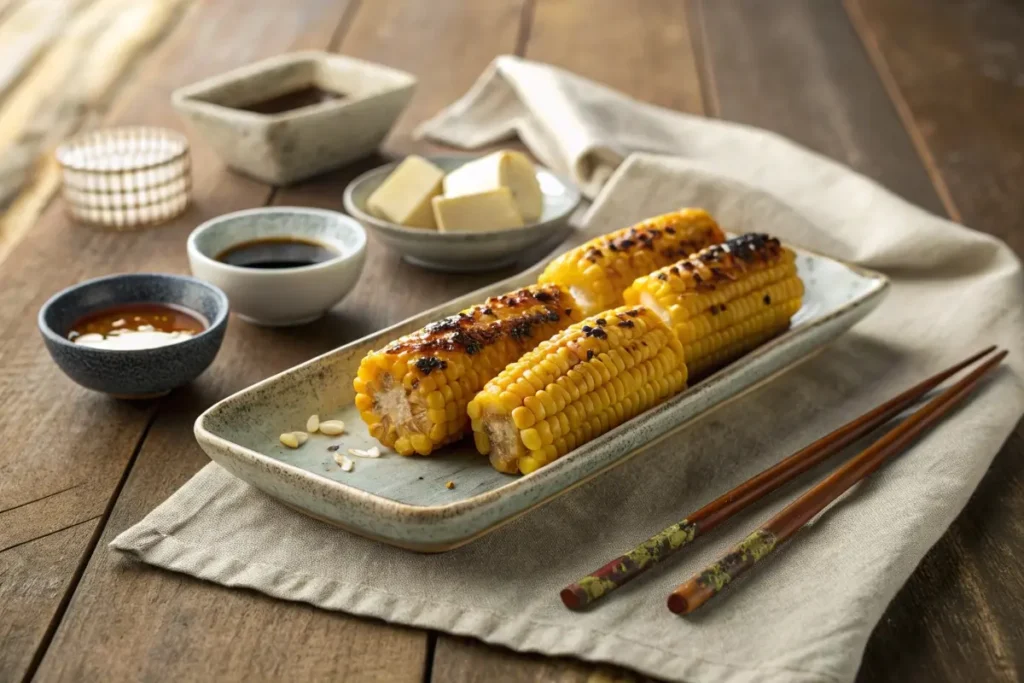
Mexican Corn on the Cob (Elote)
